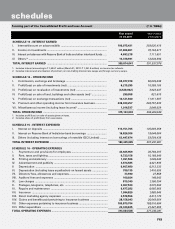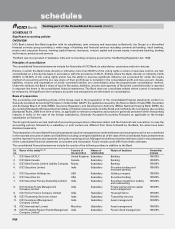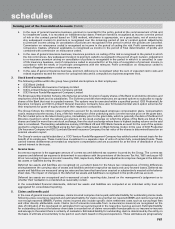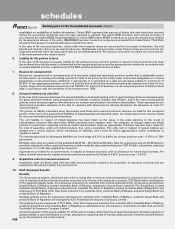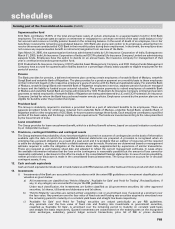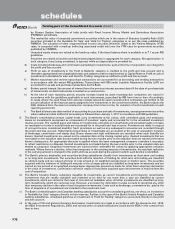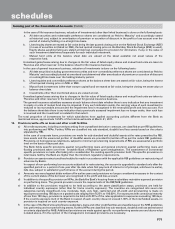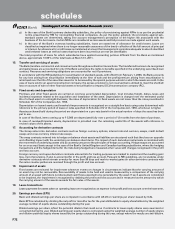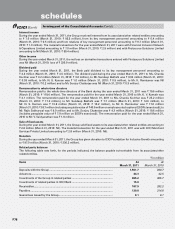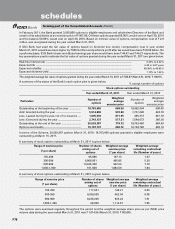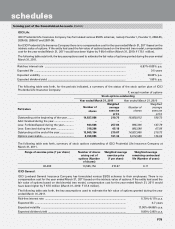ICICI Bank 2011 Annual Report Download - page 149
Download and view the complete annual report
Please find page 149 of the 2011 ICICI Bank annual report below. You can navigate through the pages in the report by either clicking on the pages listed below, or by using the keyword search tool below to find specific information within the annual report.
F71
In the case of life insurance business, valuation of investments (other than linked business) is done on the following basis:
a. All debt securities and redeemable preference shares are considered as ‘Held to Maturity’ and accordingly stated
at historical cost, subject to amoritsation of premium or accretion of discount in the profit or loss account over the
period of maturity/holding on a straight line basis.
b. Listed equity shares are stated at fair value being the last quoted closing price on the National Stock Exchange (NSE)
[in case of securities not listed on NSE, the last quoted closing price on the Bombay Stock Exchange (BSE) is used].
Equity shares awaiting listing are stated at historical cost subject to provision for diminution, if any, in the value of
such investment determined separately for each individual investment.
c. Mutual fund units at the balance sheet date are valued at the latest available net asset values of the
respective fund.
Unrealised gains/losses arising due to changes in the fair value of listed equity shares and mutual fund units are taken to
’Revenue and other reserves’ in the balance sheet for life insurance business.
In the case of general insurance business, valuation of investments is done on the following basis:
a. All debt securities including government securities and non-convertible preference shares are considered as ‘Held to
Maturity’ and accordingly stated at amortised cost determined after amortisation of premium or accretion of discount
on a straight line basis over the holding/maturity period.
b. Listed equities and convertible preference shares at the balance sheet date are stated at fair value, being the lowest
of last quoted closing price on NSE or BSE.
c. Mutual fund investments (other than venture capital fund) are stated at fair value, being the closing net asset value at
balance sheet date.
d. Investments other than mentioned above are valued at cost.
Unrealised gains/losses arising due to changes in the fair value of listed equity shares and mutual fund units are taken to
’Revenue and other reserves’ in the balance sheet for general insurance business.
The general insurance subsidiary assesses at each balance sheet date whether there is any indication that any investment
in equity or units of mutual fund may be impaired. If any such indication exists, the carrying value of such investment is
reduced to its recoverable amount and the impairment loss is recognised in the revenue(s)/profit and loss account. If at
the balance sheet date there is any indication that a previously assessed impairment loss no longer exists, then such loss
is reversed and the investment is restated to that extent.
The total proportion of investments for which subsidiaries have applied accounting policies different from the Bank as
mentioned above, approximate 14.50% of the total investments at March 31, 2011.
14. Provisions/write-offs on loans and other credit facilities
a) All credit exposures, including overdues arising from crystallised derivative contracts, are classified as per RBI guidelines,
into performing and NPAs. Further, NPAs are classified into sub-standard, doubtful and loss assets based on the criteria
stipulated by RBI.
In the case of corporate loans, provisions are made for sub-standard and doubtful assets at the rates prescribed by RBI.
Loss assets and the unsecured portion of doubtful assets are provided for/written off as per the extant RBI guidelines.
Provisions on homogeneous retail loans, subject to minimum provisioning requirements of RBI, are assessed at a portfolio
level on the basis of days past due.
The Bank holds specific provisions against non-performing loans and general provision against performing loans and
floating provisions taken over from erstwhile Bank of Rajasthan upon amalgamation. The assessment of incremental
specific provisions is made after taking into consideration the existing specific provision held. The specific provisions on
retail loans held by the Bank are higher than the minimum regulatory requirements.
b) Provision on assets restructured/rescheduled is made in accordance with the applicable RBI guidelines on restructuring of
advances by Banks.
In respect of non-performing loan accounts subjected to restructuring, the account is upgraded to standard only after the
specified period i.e. a period of one year after the date when first payment of interest or of principal, whichever is earlier,
falls due, subject to satisfactory performance of the account during the period.
c) Amounts recovered against debts written off in earlier years and provisions no longer considered necessary in the context
of the current status of the borrower are recognised in the profit and loss account.
d) In addition to the specific provision on NPAs, the Bank/the Bank’s housing finance subsidiary maintains a general provision
on performing loans. The general provision covers the requirements of the RBI/NHB guidelines.
e) In addition to the provisions required to be held according to the asset classification status, provisions are held for
individual country exposures (other than for home country exposure). The countries are categorised into seven risk
categories namely insignificant, low, moderate, high, very high, restricted and off-credit and provisioning is made on
exposures exceeding 180 days on a graded scale ranging from 0.25% to 100.00%. For exposures with contractual maturity
of less than 180 days, provision is required to be held at 25.00% of the rates applicable to exposures exceeding 180 days.
If the country exposure (net) of the Bank in respect of each country does not exceed 1.00% of the total funded assets, no
provision is required on such country exposure.
f) In the case of the Bank’s housing finance subsidiary, loans and other credit facilities are classified as per the NHB guidelines
into performing and non-performing assets. Further, NPAs are classified into sub-standard, doubtful and loss assets based
on criteria stipulated by NHB. Additional provisions are made against specific non-performing assets over and above what
is stated above, if in the opinion of the management, increased provisions are necessary.
forming part of the Consolidated Accounts (Contd.)
schedules




